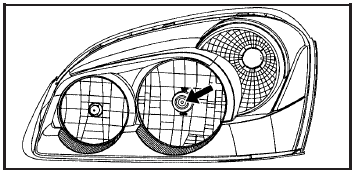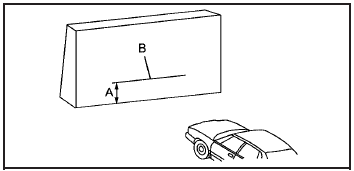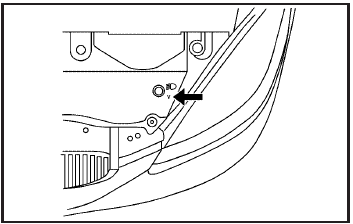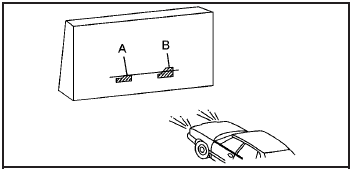Headlamp Aiming
The vehicle has a visual optical headlamp aiming system. The aim of the headlamps have been preset at the factory and should need no further adjustment.
However, if the vehicle is damaged in a crash, the aim of the headlamps may be affected and adjustment may be necessary.
If oncoming vehicles flash their high beams at you, this may mean the vertical aim of your headlamps needs to be adjusted.
It is recommended that the vehicle is taken to your dealer/retailer for service if the headlamps need to be adjusted. It is possible however, to re-aim the headlamps as described.
The vehicle should:
• Be placed so the headlamps are 25 ft. (7.6 m) from a light colored wall.
• Have all four tires on a level surface which is level all the way to the wall.
• Be placed so it is perpendicular to the wall.
• Not have any snow, ice or mud on it.
• Be fully assembled and all other work stopped while headlamp aiming is being performed.
• Be normally loaded with a full tank of fuel and one person or 160 lbs (75 kg) sitting on the driver seat.
• Have all tires properly inflated.
• Have the spare tire is in its proper location in the vehicle.
Headlamp aiming is done with the vehicle’s low-beam headlamps. The high-beam headlamps will be correctly aimed if the low-beam headlamps are aimed properly.
To adjust the vertical aim:
1. Open the hood. See Hood Release for more information.

2. Locate the aim dot on the lens of the low-beam headlamp.
3. Record the distance from the ground to the aim dot on the low-beam headlamp.

4. At a wall, measure from the ground upward (A) to the recorded distance from Step 3 and mark it.
5. Draw or tape a horizontal line (B) on the wall the width of the vehicle at the height of the mark in Step 4.
Notice: Do not cover a headlamp to improve beam cut-off when aiming. Covering a headlamp may cause excessive heat build-up which may cause damage to the headlamp.
6. Turn on the low-beam headlamps and place a piece of cardboard or equivalent in front of the headlamp not being adjusted. Do not place directly on the headlamp. This allows only the beam of light from the headlamp being adjusted to be seen on the flat surface.

7. Locate the vertical headlamp aiming screws, which are under the hood near each headlamp assembly.
The adjustment screw can be turned with a 6 mm male hex.
8. Turn the vertical aiming screw until the headlamp beam is aimed to the horizontal tape line. Turn it clockwise or counterclockwise to raise or lower the angle of the beam.

9. Make sure that the light from the headlamp is positioned at the bottom edge of the horizontal tape line. The lamp on the left (A) shows the correct headlamp aim. The lamp on the right (B) shows the incorrect headlamp aim.
10. Repeat Steps 7 through 9 for the opposite headlamp.
See also:
Clock
The infotainment system controls are used to access the time and date settings
through the menu system. The clock menu can be only be used with the radio on while
in ON/RUN or ACC/ACCESSORY.
See ...
Where to Put the Restraint
According to accident statistics, children and infants are safer when properly
restrained in a child restraint system or infant restraint system secured in a rear
seating position.
We recommend t ...
Power Door Locks
Power Door Locks
(Unlock): Press to unlock all
doors.
(Lock): Press to lock all doors.
See “Power Door Locks” in Vehicle
Personalization. ...


